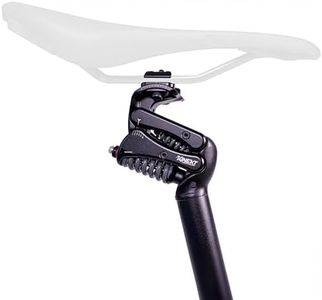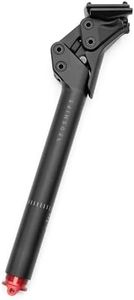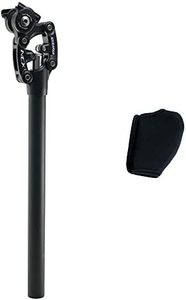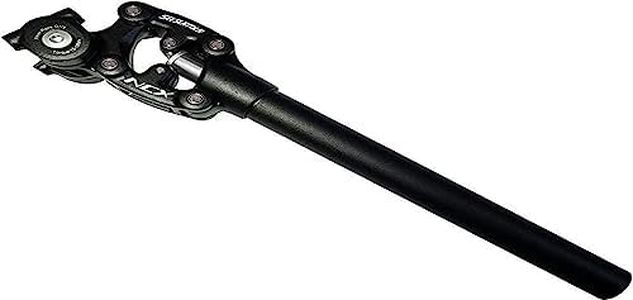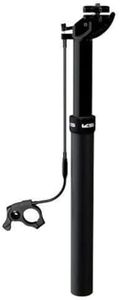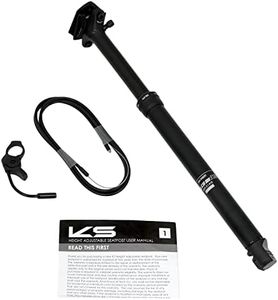We Use CookiesWe use cookies to enhance the security, performance,
functionality and for analytical and promotional activities. By continuing to browse this site you
are agreeing to our privacy policy
10 Best Suspension Seat Post
From leading brands and best sellers available on the web.Buying Guide for the Best Suspension Seat Post
Choosing a suspension seat post can greatly improve your cycling comfort, especially if you frequently ride on rough roads or trails. The main purpose of a suspension seat post is to absorb shocks and vibrations, reducing the strain and fatigue on your back and hips. To pick the best one for your needs, it’s important to understand the key specifications and features that affect performance and comfort. By considering how and where you ride most often, you can focus on the specs that matter most.TravelTravel refers to how much the seat post can compress to absorb bumps. It's measured in millimeters and basically shows how much cushioning you’ll get. Short-travel seat posts (20-40mm) are best for smoother roads or light gravel, where small vibrations need to be softened. Medium-travel options (40-60mm) are suitable for mixed terrain, offering more noticeable shock absorption. Long-travel posts (over 60mm) are generally used for off-road or mountain biking, where you regularly encounter big bumps and drops. To choose the right travel for you, think about your typical riding surface: smoother roads merit less travel; bumpy trails call for more.
Spring TypeThe spring or damping mechanism inside the post determines how it absorbs shocks. Options commonly include coil springs, elastomers (rubbery blocks), or air mechanisms. Coil springs provide a traditional feel and can take bigger hits, making them popular with mountain bikers. Elastomers are softer and lighter, ideal for casual riders looking for gentler cushioning on moderate routes. Air mechanisms are more adjustable and lightweight, suiting those who want to fine-tune the feel. You should think about what type of ride quality you prefer and how much maintenance you want—coil and elastomer types are lower maintenance, while air types offer more adjustment.
DiameterDiameter is the width of the seat post where it fits into your bike frame, usually measured in millimeters. Common sizes include 27.2mm, 30.9mm, and 31.6mm. It’s crucial to match the diameter of the seat post to your bike’s seat tube, or it won’t fit correctly. To pick your size, check your bike’s manual or measure the inside diameter of your seat tube with calipers. Choosing the wrong size means the post may not fit or be unsafe.
LengthThe overall length of the seat post affects both how much seat height adjustment you have and how much of the post supports your weight. Longer posts offer more adjustment and are good for taller riders or those needing to raise the saddle higher. Shorter posts suit smaller frames or people who don’t need much height. When picking length, ensure you have enough post inserted into the frame for safety, while also having enough above the frame for your leg extension.
SetbackSetback refers to how far the seat is positioned behind the center of the seat post. This affects your riding posture and can help fine-tune your fit and comfort. Posts with zero or minimal setback keep your weight directly over the pedals for a more upright, efficient position, suitable for most casual riders. Posts with noticeable setback allow for a more stretched or relaxed seating position, which some riders prefer for longer rides or for relieving knee strain. When choosing, consider your flexibility, preferred riding posture, and any fit guidance from a professional fitting session.
AdjustabilityAdjustability means the ways you can change the feel or characteristics of the seat post, such as spring tension, rebound speed, or even lockout for a rigid feel. Posts with simple adjustability can be set and forgotten, while those with advanced controls offer fine-tuning for more demanding riders. Think about how much you like to tinker with your gear—if you want a set-and-forget solution, basic adjustability is fine, while enthusiasts may prefer more options.
WeightWeight affects the overall mass you’re carrying on your bike, which can be important for performance or easy handling. Lighter posts are popular with road cyclists who care about efficiency, while commuters or casual riders may not mind a little extra heft if it means more comfort or durability. Consider your priorities—lighter posts are more expensive and delicate, heavier ones are often more robust and cost-effective.

